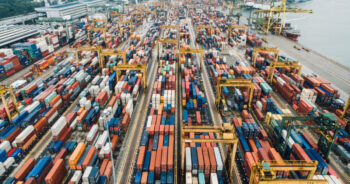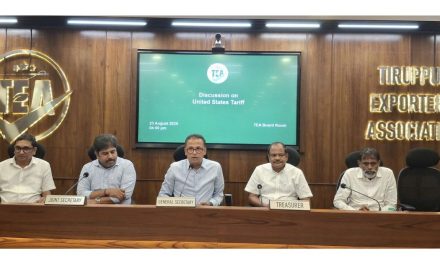 Textile exports from Tamil Nadu – India’s top textile exporting state saw a slight drop to $7.1 bn in FY24 as against $7.9 bn in the previous fiscal. Share of exports from Tamil Nadu to the overall textile export value too marginally dropped to 20.78 per cent against 22.58 per cent in the previous year, according to Government data.
Textile exports from Tamil Nadu – India’s top textile exporting state saw a slight drop to $7.1 bn in FY24 as against $7.9 bn in the previous fiscal. Share of exports from Tamil Nadu to the overall textile export value too marginally dropped to 20.78 per cent against 22.58 per cent in the previous year, according to Government data.
Within total textiles exports from the State, readymade garments was $4.69 bn; cotton yarn/fabrics/made ups, handloom products was $2.06 bn; manmade yarn/fabrics/madeups was $286 mn; handicrafts excluding handmade was $89.20 mn; carpet 19.17 mn and carpet jute Manufacturing, including floor covering was $5.85 million. Gujarat was the second largest exporter of textiles and at the third position was Maharashtra, the data said.
Siddhartha Rajagopal, Executive Director, Texprocil, said, overall exports of textiles have dropped by 3.24 per cent in fiscal year 2023-24 compared to the earlier year. At the same time it needs to be highlighted that the export of cotton textiles for the year 2023- 2024 have reached $11,683 mn, growing by approx. 6.7 per cent over the previous year. “This is a bright spot within the overall textile and apparel basket,” he said.
As regards Tamil Nadu, the decline has been a very marginal 2.2 per cent lower than the overall drop in textile exports. The main reasons for decline in Tamil Nadu were the high raw material prices in the initial months of the earlier fiscal year, low capacity utilisation by spinning units and the low off take of garments, which has also led to an overall decline in apparel exports from India by (-) 10.25 per cent.
Going forward the position should improve for both Tamil Nadu and India on the export front as demand stabilises, price of raw materials remain range bound and the India- UK FTA is signed, he said.
On the drop in textile exports from Tamil Nadu, Indian Texpreneurs Federation’s Prabhu Dhamodharan said, “We need to keep in mind the fall in commodity prices and its impact on apparel product export prices while comparing the YoY numbers. Based on that factor, the drop in value may not translate exactly in to volume numbers.”
Another influencing factor is fall of demand for knitted apparels globally due to excessive buying during the previous year resulted in higher inventory levels with retailers. TamilNadu being a dominant player in knitted apparel exports faced this cyclical issue, he said.
Apart from these cyclical issues, a few structural issues are also emerging now. Tamil Nadu’s textile and apparel sector known for its quality products need to build scale, competitiveness, specialisation and market diversification strategies to compete with other emerging states and also competing countries. “Some good efforts are going on in our clusters in all these aspects and we may bounce back soon with growth in this FY 24-25,” he said.
Sustainable garments using recycled materials and cellulosic fibres also getting traction here in our region and that will help in capturing the higher value add orders to improve our overall value in exports, said Dhamodharan.
On action that needs to be taken to boost the textiles sector in Tamil Nadu, Dhamodharan said the State’s textile and apparel sector is strategically positioning itself to capitalise on the “China plus one” trend, and focusing on enhancing competitiveness and specialisation over the next decade.
The industry emphasises the importance of a stable policy environment, particularly regarding zero tax regime on raw material imports. This stability is crucial for improving value-added exports within the textile value chain, particularly in the Western region of Tamil Nadu.
Tamil Nadu Mitra Park
The swift execution of Tamil Nadu Mitra Park is important for expanding processing capacity, which in turn will bolster valueadded exports. Ensuring timely implementation is essential to realise China plus one opportunity and enhance the sector’s competitiveness.
Modernisation
To maintain competitiveness, the spinning sector in Tamil Nadu requires modernisation. Providing one-time support for modernisation efforts and allocating additional funds to newly launched modernisation support schemes from the State will facilitate the modernization of the yarn sector. This modernisation is essential for regaining market share in yarn exports, he said.





















